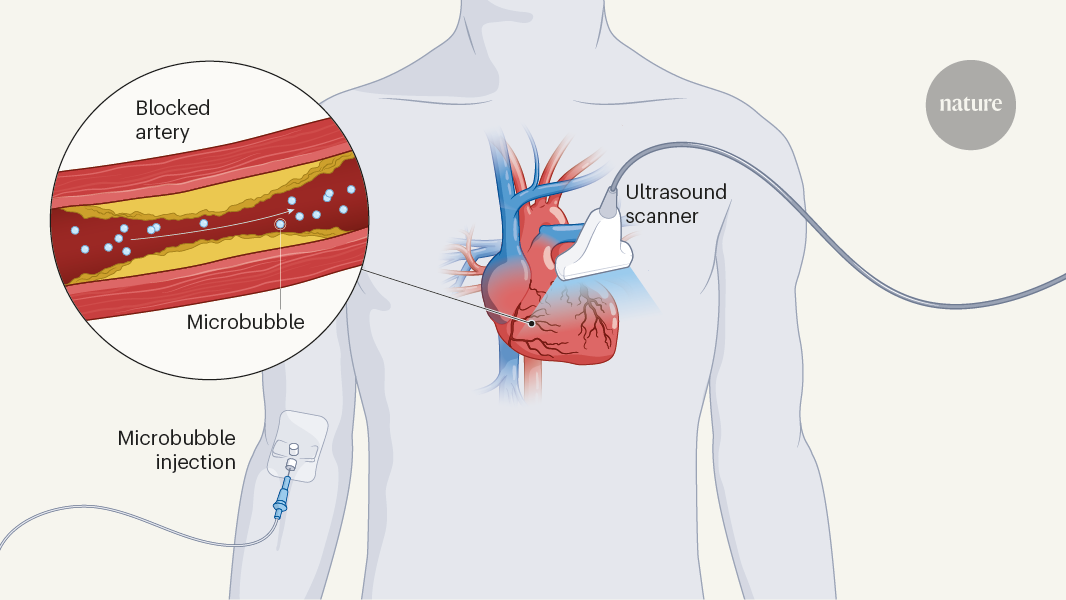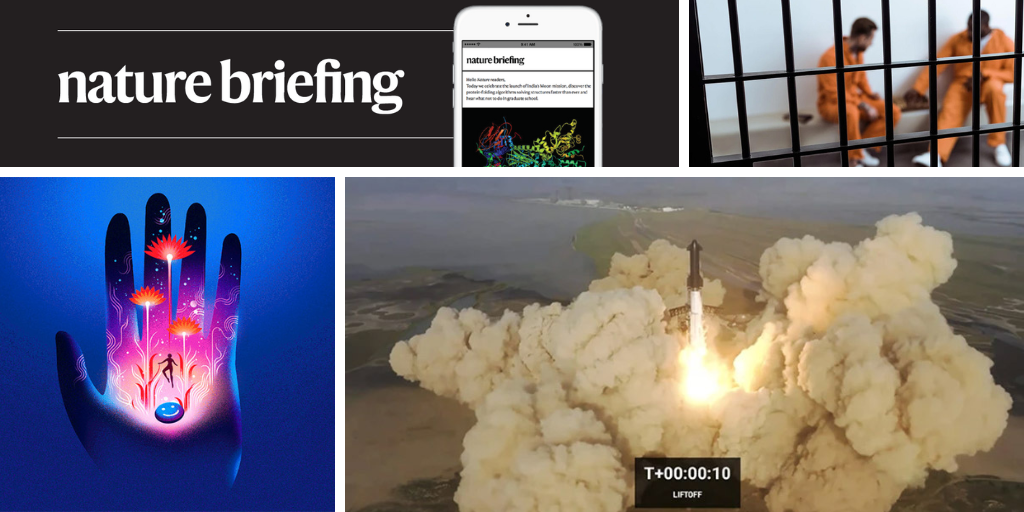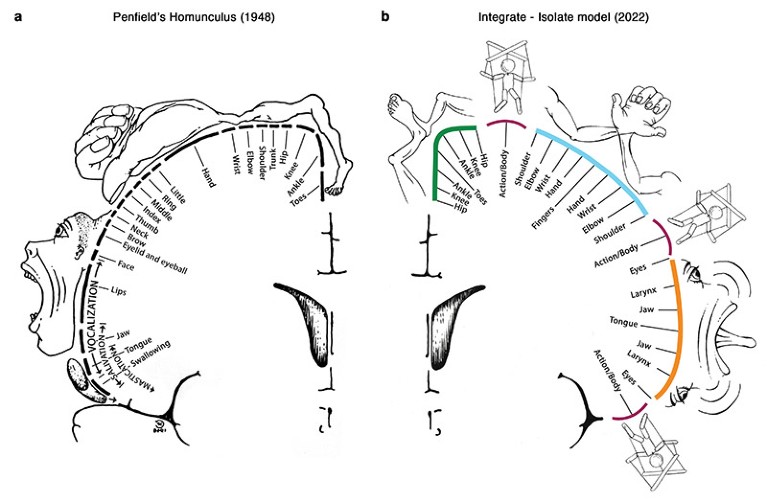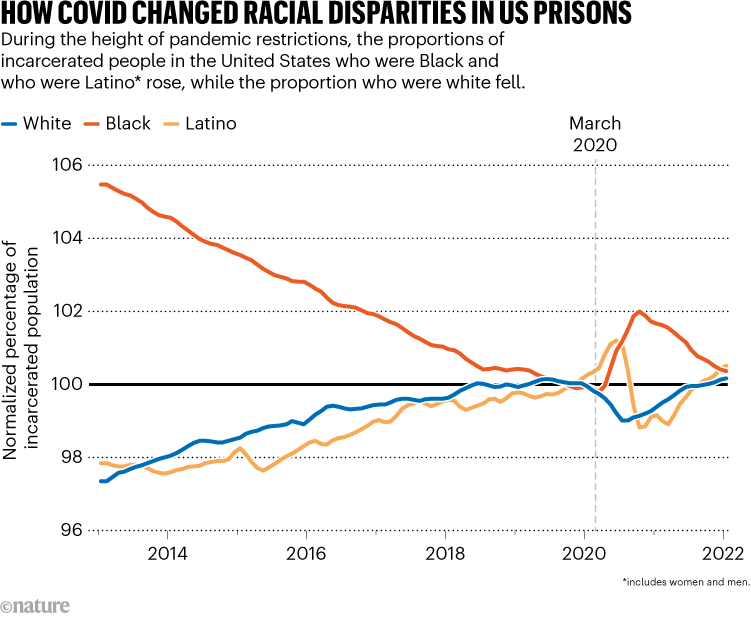Hello Nature readers, would you like to get this Briefing in your inbox free every day? Sign up here.
Neurosurgeon Wilder Penfield’s 1948 diagram of the motor homunculus (left) shows the areas of the primary motor cortex that control each body part. A new study redraws the diagram (right), adding regions connected to brain areas responsible for coordinating complex movements.Credit: E. Gordon et al./Nature
The iconic ‘homunculus’ diagram, which shows how the brain controls individual body parts, has been overhauled to include complex movements. Since the 1930s, the diagram has been used to show a brain region called the primary motor cortex and how it dedicates much more space to some body parts, such as the hands and mouth, than others. Now, hours of magnetic resonance imaging have revealed three interconnected areas that aren’t specific to any one body part. Instead, they connect to parts of the brain that are responsible for critical thinking, maintaining the body’s physiology and planning actions.
SpaceX’s enormous Starship vehicle and its booster successfully left the launch pad for the first time today, but blew up 4 minutes later during a planned separation. No people or satellites were on board. Starship is the most powerful rocket ever to leave the Earth’s surface. As well as ferrying astronauts to the Moon and, one day, to Mars, it could launch heavy science payloads, such as telescopes. Rocketeers were prepared for the test to experience some hiccups. “Everything after clearing the tower was icing on the cake,” said SpaceX engineer Kate Tice just before the rocket exploded on the live broadcast..
The COVID-19 pandemic brought about the largest ever fall in the US prison population as courts closed and more cases were dismissed without trial. As the number of people in prison dropped, the proportion of Black people in US prisons began to rise. Researchers combed through disparate data from prisons in state and federal prison systems to reveal that the effect was down to the longer sentences, on average, that Black people in the United States receive relative to white people.
Go deeper with an analysis by legal scholar Jessica M. Eaglin in the Nature News & Views article (7 min read, Nature paywall)
Source: Ref. 1
Features & opinion
Conventional reference genomes do a poor job at capturing genetic diversity. The solution is the pangenome: composite references made from tens or even thousands of individual genomes. The first human pangenome is based on 47 individual genomes. By 2024, the goal is to push this number to 350 — although it’ll take time for researchers to ditch familiar references for the complex pangenome maps. Pangenomes could help to uncover the hidden variation underlying complex medical and developmental conditions, such as autism spectrum disorder.
The US government could soon approve the hallucinogenic drug MDMA to treat post-traumatic stress disorder (PTSD). Psychedelics had long been investigated as mental-illness treatments, until their ban made them difficult to study. The theory is that MDMA allows people to confront their trauma by dampening the fight-or-flight response. Questions linger about how MDMA will be administered and by whom: in recent clinical trials, the drug was combined with psychotherapy, which isn’t regulated. And because MDMA has been around since 1912 and cannot be patented, there’s little financial incentive.
You’ll need a phone for recording audio, some free editing software such as Audacity and, most importantly, a good idea, explains Kellen Cavagnero, who runs the immunology podcast Inflammatory Content. Episodes can be hosted on SoundCloud and then uploaded to Apple Podcasts and Spotify. Further down the line, you can experiment with episode formats, add music (for example from Google’s Audio Library) or use professional recording equipment. “Not only has Inflammatory Content had a positive impact on the listeners, but by forcing me to listen carefully and communicate clearly and concisely, it has made me a better scientist and educator,” says Cavagnero.
Scholars should be wary of using and recommending large language models (LLMs) run by companies that do not disclose their underlying model, argues political scientist Arthur Spirling. Proprietary LLMs throw a wrench into reproducibility because you can never know how their underlying training data will change. They raise ethical concerns because they might be based on content that wasn’t shared with informed consent. And as companies rise and fall, an LLM that is key to important research could become expensive or disappear altogether. “Massive collaborative projects urgently need support to produce open-source models for research,” writes Spirling.
Today I’m gazing at the quiet beauty of a total solar eclipse that was visible earlier today in Australia. I have seen a partial eclipse and can vouch for the fact that it was mind-boggling. Readers in North America will have a chance to find out for themselves when the ‘Great North American eclipse’ crosses Mexico, the United States, and Canada on 8 April, next year.
Share the natural event that you found most memorable — plus any feedback on this newsletter — with me at [email protected].
Thanks for reading,
Flora Graham, senior editor, Nature Briefing
With contributions by Gemma Conroy and Katrina Krämer
We’ve recently launched two new e-mails you might like. They’re free, and of course you can unsubscribe at any time.
• Nature Briefing: Cancer — a new weekly newsletter written with cancer researchers in mind. Sign up here to receive the next one.
• Nature Briefing: Translational Research covers biotechnology, drug discovery and pharma. Sign up here to get it free in your inbox each week.









More News
Microbubble ultrasound maps hidden signs of heart disease
I make 3D models of conifer needles to explore their climate effects
How rich is too rich?